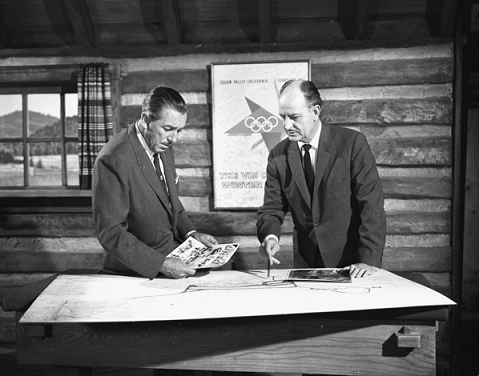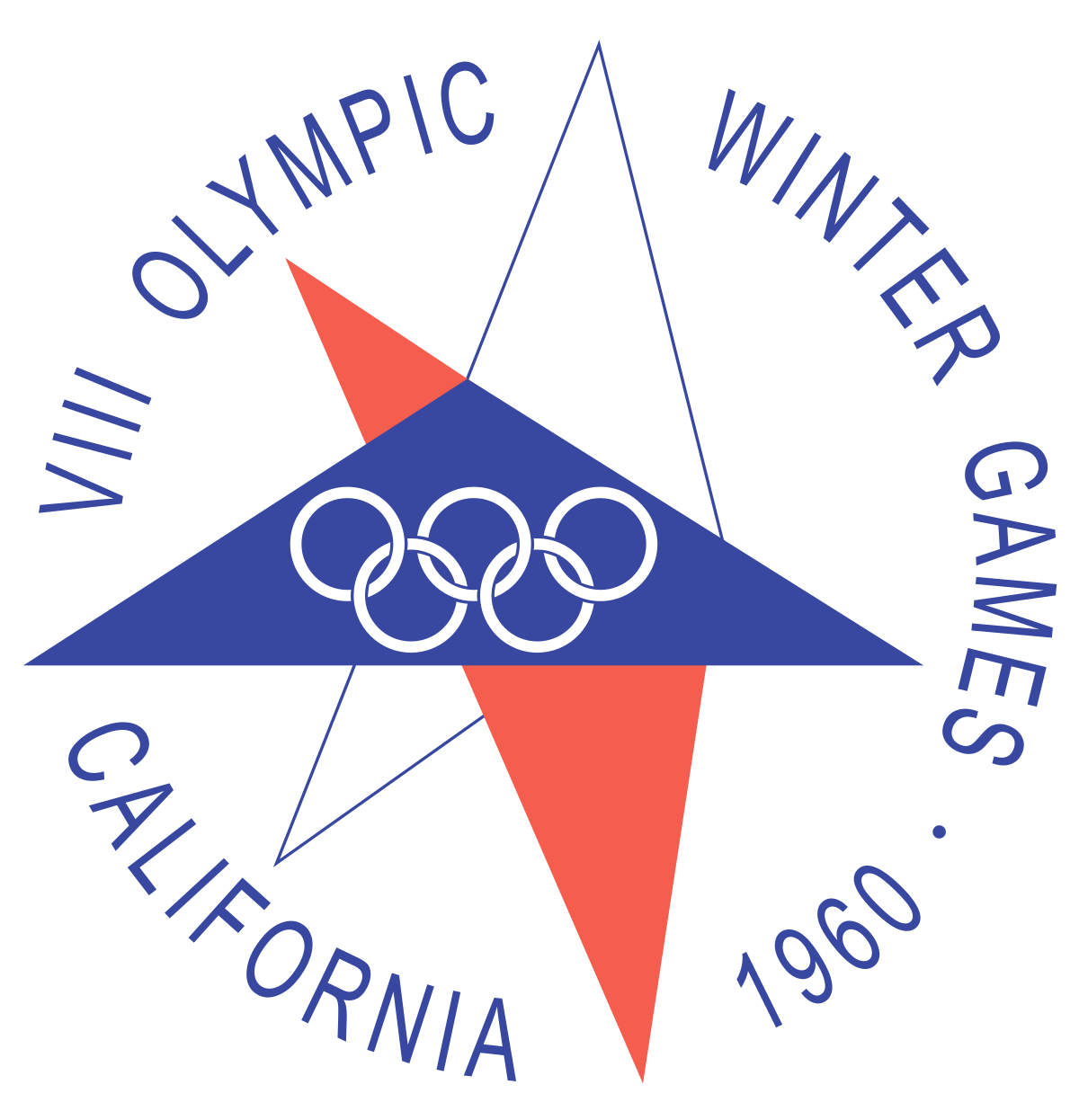Movies, television, theme parks, are just some examples of how Walt Disney’s brilliance and imagination has changed the modern world. Walt was a man of vision, who worried not about expense, but about quality of a product. At the height of his popularity, power, and talent, Walt Disney was invited to the Olympic stage.
His involvement in the VIII Olympic Winter Games in Squaw Valley, California was destined to happen. Having Walt Disney become the Chairman of the Pageantry Committee, which would oversee the opening and closing ceremonies of the games, as well as the theming for the games itself, was the perfect addition to this fairy tale story.
The idea of hosting the Olympics at Squaw Valley in California was the brainchild of Alexander Cushing, the owner and operator of the struggling singular ski resort in Squaw Valley. The idea was a lark that shocked the world in 1955, outbidding the Europeans, and securing the games for America, for the first time since 1932.
For the fairy tale to not become a nightmare, work had to begin immediately. Squaw Valley was so remote that there was no local government official to receive the Olympic Flag. The duty fell to an International Olympic Committee (IOC) member from California. The building began with all haste.
What seemed like a disadvantage turned into a blank slate for the Squaw Valley Olympics. With only one chair lift, two tow ropes, and a 50-room lodge, the Olympics would be built from scratch taking the once small ski resort to a whole new athletic level. Alexander Cushing, not only owned the ski resort, but much of the surrounding land. His lark would turn out to be profitable for him.
Construction of the venues began, and by 1958, Walt Disney was recruited by Prentis Hale, the organizing committee president, to run the opening and closing ceremonies. As Pageantry Director, Walt would bring his wonder to sports stage.
But not all were happy with the Disney addition. Many officials complained that the Olympics would turn into another Disneyland, and distract from the true meaning of the games. As Walt set about his plans, the cost related to his ideas was started to rise. Officials who were uncertain about involving Disney, started to balk at the expense. Walt’s response was that if they couldn’t accommodate him, then he would simply pull out. Complaints stopped, and Walt continued.
He hired his son in law, Ron Miller, as the Pageantry Coordinator, Card Walker as Director of Publicity, and Imagineering legend John Hench. The VIII Olympic Winter Games would be in good hands.
For the Opening Ceremonies hundreds of school bands would take part in playing all the music. Gathered from thousands of auditions, the kids of these collective bands would have to make their own way to the games, and back home with no help from the Olympic committee.
Youth would also play an important part in the running of the day to day operations. With over 125 Explorer Scouts, these young individuals would be responsible for not only acting as official flag raisers, messengers, but also as a part of crowd control throughout the games.
As time pressed on the VIII Olympic Winter Games looked ready for the opening ceremony. The world athletes would be coming to a competition that would span many firsts.
Squaw Valley was the first Olympics to be nationally broadcasted. CBS paid $50,000 for the television rights to the Olympics. From opening ceremonies to the closing moments, CBS would be on the air with all the information.
This was also the first Olympics to use instant replay. With CBS recording all the events, the judges and Olympic officials used this opportunity to start the instant replay that we now see in all sports.
Another first – a dedicated athlete’s village. Prior events had athletes put up in hotels or local residences. Since Squaw Valley only had one 50 room lodge an entire village was built for the thousands of athletes.
On opening day, February 18th, 1960, it looked like all the preparation would be spoiled by Mother Nature. Walt had conceived a magical opening to the games with elaborate plans for all the musicians to perform outside, as well as a special presentation of fireworks during the day. Unfortunately, a snow storm had rolled in threatening to cancel Walt’s grand outdoor spectacle. As the start time approached, Olympic officials pressured Walt to move the celebration inside to the arena. Walt held on to hope and waited another fifteen minutes past the start time. He was also feeling pressure from the band leaders who worried that if the ceremonies went inside the musicians, who funded their own way to the Olympics, would not be seen on television. His patience paid off. In true fairy tale fashion, at the last second, the sky cleared, the snow stopped, and the sun shined through.
The games had Walt Disney influences throughout, from explosive fireworks to the statues people passed by, and even the torch that was held. John Hench created thirty sixteen-foot-tall ‘snow’ statues of different athletes who were competing at the games. Two, twenty-four-foot statues of a male and female athlete bookended the Tower of Nations which represented all the nations competing at the games. The Tower of Nations, statues, and even the refined version of the torch were all created by Hench, and are in many ways still used today. The Tower of Nations was also the location of the medal ceremonies that athletes attended each day to be awarded their medals in full view of everyone. This was another first for the Olympics.
Walt not only influenced and changed the look of the games, he changed the attitude at the games. Prior to the VIII Olympic Winter Games, there was no real entertainment established for the athletes. Walt eradicated this, and offered nightly entertainment for the competitors, Hollywood stars like Bing Crosby, Dany Kaye, Art Linkletter and others were brought in to entertain with nightly shows, which ended up being a huge success entertaining 1500 athletes, officials, and reporters each night at 8:30 p.m. While many Olympic officials were concerned that this would distract the athletes from focusing, it ended up being a great reprieve for the focused competitors.
The VIII Winter Olympic Games in Squaw Valley was a success, even though it looked like a perfect recipe for a disaster. Walt Disney not only brought his creativity, but also his specialty in entertainment, and took the Olympics to a new level of spectacle. Unlike what many officials thought would happen, the VIII Winter Olympics didn’t become another Disneyland, instead it became an example of what Walt Disney was able to do thanks to his own brilliance as well as the skill and ingenuity of the people who worked for him like Ron Miller, Card Walker, and especially John Hench.
The VIII Winer Olympic Games ran from February 18th-28th, and came at a perfect time in Walt’s life. He was looking to expand his creativity and involvement in projects outside of Disneyland, and the Olympic opportunity allowed him to experiment with ideas that he hoped to use elsewhere. His idea for a ski resort at Mineral King was being thought about at this time, as well as expanding his reach into the World’s Fair in New York during the 1964-1965 season. 1960 was the beginning of Walt Disney reaching beyond the Anaheim border, and what better place to start then the Olympics.


